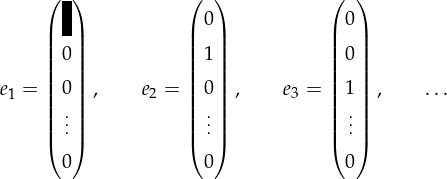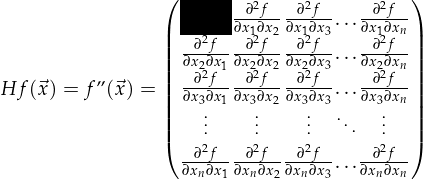|
|
|
|
|
|
| Terms
|
|
|
|
|
|
Classes of
Systems |
Given a dynamic system
-
Dynamic system
-
Time-invariant system is a dynamic system
-
Autonomous system is a dynamic system
-
Linear system (W) is a dynamic system
-
Linear time-invariant system is a linear system and a time-invariant system
|
|
|
|
|
|
|
Lipschitz
Continuity
(W,) (UC
Berkley) |
Lipschitz continuous functions are continuous and differentiable almost anywhere in a domain.
Given a domain D and a function f : D →R, D ∈Rn,
f is Lipschitz continuous if ∃L > 0 such that |f(x) −f(y)| < L||(x−y)||∀x, y ∈ D |
|
|
|
|
|
|
Hessian
(W), (Kahn
Academy),
(Wolfram) |
|
|
|
|
|
|
|
definite
(W) |
Warning: this definition does not appear to be common outside of controls
Given a real-valued, continuously differentiable function V(x) : R →R
V(x) can be classified as
-
(globally) positive semidefinite if
(v is greater than or equal to 0 regardless of x)
-
(globally) positive definite if positive semidefinite AND
(V(x) is zero if and only if x is zero)
-
(globally) negative semidefinite if
(v is less than or equal to 0 regardless of x)
-
(globally) negative definite if negative semidefinite AND
(V(x) is zero if and only if x is zero)
-
locally positive definite (l.p.d) if
where N is a small open neighborhood containing 0
(v is greater than or equal to 0 regardless of x in some small open neighborhood N that contains the zero
vector)
(V(x) is zero if and only if x is zero)
Note that the criteria for a function to be locally positive definite are similar, but more relaxed than, those for
globally positive definite functions.
- positive definite on some domain D ∈Rn if
we only care if the conditions for positive definite functions hold for all x in D.
|
|
|
|
|
|
|
Stability
(MIT) |
Given an autonomous system
and some open connected region 𝒟 containing 0
Stability is usually used to describe trajectories around the origin of a system.
-
Stability
The equilibrium point x = 0 is stable if ∀𝜖 > 0, ∃δ(𝜖) > 0 such that  < δ < δ   < 𝜖 < 𝜖
-
In the sense of Lyapunov
If there exists a scalar, continuously-differentiable function V(x) such that
(V(x) is a locally positive definite function)
(V(x) is a locally negative semidefinite function)
then the origin is stable in the sense of Lyapunov, and V(x) is a Lyapunov function of
f(x).
- Instability
The equilibrium point x = 0 is unstable if it is not stable
-
Asymptotic stability
The equilibrium point x = 0 is asymptotically stable if it is stable and ∃δ1 such that
 < δ1 < δ1  lim t→∞x(t) = 0 lim t→∞x(t) = 0
-
Exponential stability
- Uniform stability
The equilibrium point x = 0 is uniformly stable if it is stable and, for each epsilon > 0, there exists a
δ(𝜖) > 0, independent of t0. |
|
|
|
|
|
|
Stability
(continued) |
|
|
|
|
|
|
|
Class κ
function |
A continuous scalar function on R+ is
-
class κ if it is:
- zero at zero
- strictly increasing
- continuous
-
class κ∞ if it is:
- zero at zero
- strictly increasing
- continuous
- ∞ at ∞
|
|
|
|
|
|
|
Radially
Unbounded
function |
A function V(x) is radially unbounded if
|
|
|
|
|
|
|
sup
(supremum) |
Like a maximum of a functions, but includes limits that aren’t necessarily a part of the domain of the
function. (TODO) |
|
|
|
|
|
|
Hurwitz |
- Hurwitz (polynomial):
A polynomial whose roots that are all in the left-half plane. (In other words, the real part of every
root is strictly negative)
- Hurwitz (matrix) (W):
A square matrix whose characteristic polynomial is Hurwitz, meaning all eigenvalues are in the left-half
plane. (In other words, the real part of every eigenvalue is strictly negative)
- Routh-Hurwitz stability criterion (IEEE):
TODO
Any hyperbolic fixed point (or equilibrium point) of a continuous dynamical system is locally asymptotically stable
if and only if the Jacobian of the dynamical system is Hurwitz stable at the fixed point.
A system is stable if its control matrix is a Hurwitz matrix.
The negative real components of the eigenvalues of the matrix represent negative feedback. Similarly, a system is
inherently unstable if any of the eigenvalues have positive real components, representing positive
feedback. |
|
|
|
|
|
|
Zero-state
observable |
A time-invariant system of the form
is zero-state observable if
In other words, when u = 0, any nonzero state behavior will be observed at the output (y≠0) |
|
|
|
|
|
|
Sets |
-
Invariant Set
A set of vectors M is invariant with respect to ẋ = f(x) if
(if a solution belongs to M at some time instant, then it belongs to M for all future and past time)
-
Positively Invariant Set
A set of vectors M is positively invariant with respect to ẋ = f(x) if
(if a solution belongs to M at some time instant, then it belongs to M for all future time)
-
Open Set
A set D ⊂Rn (D, which is a set of real vectors) is an open set if
(for all vectors x in the domain D, there exists a real scalar 𝜖 such that we can create a ball around x with
radius 𝜖, and that whole ball is in D)
-
Closed Set
A set D ⊂Rn (D, which is a set of real vectors) is a closed set if
(everywhere outside of D is open)
-
Bounded Set
A set D ⊂Rn (D, which is a set of real vectors) is a bounded set if
(D fits in a ball with a finite, constant radius 𝜖)
- Compact Set
A set D ⊂Rn (D, which is a set of real vectors) is a compact set if it is closed and bounded.
|
|
|
|
|
|
|
Passivity |
For a system y = h(u, t), h : Rm × →Rn →Rn
(output state y (an n-dimensional vector) is a function of the input state u (an m-dimensional vector) and
time t)
|
|
|
|
|
|
|
Adjoint |
-
The {adjoint or Hermitian transpose}of a matrix A (Wolfram) is its conjugate transpose, denoted
as A′, A∗, AH, or A† i.e.
Interesting properties of ajoint matrices:
- AH = AT = AT
- If a matrix is its own conjugate transpose, that matrix is called self-adjoint or Hermetian
- If A is a real matrix, AH = AT
Warning: In some older literature, the ”adjoint of a matrix” may mean the adjunct matrix of a square
matrix (W)
- The adjoint representation of a vector space (Wolfram)
(TODO)
- The adjoint equation (W)
(TODO)
|
|
|
|
|
|
|
|
|
|
|
|
| | |














































